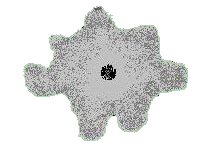... ist sehr wichtig für die Wissenschaft! ... is very important for science!
Name: Dictyostelium discoideum
Spitzname: Dicty
Klasse: Schleimpilz / Myxomycet
Unterklasse: Zelluläre Schleimpilze
Ordnung: Dictyosteliales
Familie: Dictyosteliaceae
Gattung: Dictyostelium
Art: Dictyostelium discoideum
Name: Dictyostelium discoideum
Nickname: Dicty
Class: Protista
Unterklasse: Cellular Slime Molds
Order: Dictyosteliales
Family: Dictyosteliaceae
Genius: Dictyostelium
Species: Dictyostelium discoideum

Vorkommen in der Natur: Waldböden
Größe: 8-12µm als Einzeller
Fruktifikationen: aus toten Stielzellen und keimfähigen Sporen
Fortbewegung: ähnlich wie Amöben und Physarum, über Scheinfüßchen, meist in Richtung von Nahrung
Lieblingsessen: Bakterien
Hobbys: Fressen, Schwimmen und mich über Mitose exponentiell vermehren
Einsatz in Wissenschaft: Wichtiges Modell zur Entschlüsselung des Übergangs von einem Ein- zu einem Vielzeller
Distribution in Nature: Forest grounds
Size: 8-12µm as unicellular organism
Fructifications: from dead stalk cells and germinable spores
Movement: similar to amebae and Physarum via pseudopodia, usually in the direction of food
Favorite food: Bacteria
Hobbies: Eating, swimming and exponential growth via mitosis
Mission in science and research: Important model for the decryption of the transition from a uni- to a multicellular organism
Besonderheiten:
Der Entwicklungszyklus von Dictyostelium discoideum unterscheidet sich stark von dem eines Physarum polycephalums.
Dicty ist ein Einzeller und sehr, sehr klein, sind die Umstände nahrungstechnisch günstig für ihn, so bleibt er auch ein Einzeller (mit nur einem Zellkern!). Er teilt sich durch Mitose, wobei die entstandenen Tochterzellen auch wirklich auseinander gehen (im Gegensatz zu Polly).
Findet Dicty nicht genügend Nahrung, sendet er den Botenstoff cAMP aus, welcher von anderen Dicties erkannt wird, die nun ebenfalls cAMP ausscheiden und sich aufeinander zu bewegen. Dies ist nun die Phase, wo sich langsam ein Vielzeller entwickelt: Die einzelnen Dicties bilden ein sogenanntes Pseudoplasmodium, welches äußerlich zwar dem Plasmodium eines "gewöhnlichen" Schleimpilzes ähnelt, jedoch schmelzen die Zellen nicht zusammen, sondern bleiben getrennt. Diese Andichtung kann durchaus Werte von 400 Zellen pro Quadratmillimeter erreichen.
Die Zellen differenzieren nun (nehmen verschiedene Aufgaben an), wie man es eigentlich nur von Organismen mit mehreren Zellen kennt. Ein Teil wird zu "Prä-Sporenzellen" (bilden bei der Fruktifikation später die keimfähigen Sporen) und der andere zu "Prä-Stielzellen" (bilden bei der Fruktifikation später den Stiel und sterben ab). Die Form, die dieser Zellhaufen nun annimmt, wird als "Schnecke" bzw. engl. "Slug" bezeichnet. In dieser Formation reagieren die Zellen nun gemeinsam auf äußere Reize und begeben sich gemeinsam auf Nahrungssuche.
Finden sie wieder ausreichend Bakterien, löst sich der Zellverband wieder auf und die Dicties leben als Einzeller weiter.
Finden sie jedoch keine Nahrung, bilden sich die Fruktifikationen aus den nun toten Stielzellen mit den keimfähigen Sporen. Aus den Sporen können unter geeigneten Bedingungen wieder einzellige Dicties entstehen.
Quelle und weiterführende Informationen: Wikipedia.
Rund um Dictyostelium discoideum dreht sich diese Website (Englisch): dictybase.org.
Special Characteristcs:
The life cycle of Dictyostelium discoideum is very different from Physarum polycephalum.
Dicty is a unicellular being and very, very small. If the environment allows it (in terms of food supply) it stays a unicellular organism (with only one nucleus!). Dicty divides itself via mitosis and the resulting cells truly separate and go their own ways (in contrast to Polly).
If Dicty doesn't find enough to eat, it sends out a messenger substance called cAMP, which will be recognized by other Dicties who respond by sending out cAMP themselves and move towards each other. This is the phase in which, slowly, a multicellular organism is growing: The individual Dicties form a so-called Pseudoplasmodium, which might look like a Plasmodium of a "regular" slime mold. However, the cells don't meld but stay separated. This way, such a Pseudoplasmodium can reach a density of 400 cells per square millimeter.
These cells then begin to differenciate (take on different tasks), a phenomenon that is actually only known of multicellular beings. Some of the cells become "pre spore cells" (which will form the germinable spores during fructification), the other cells turn into "pre stalk cells" (which will then die and be the stems of the fructification). The shape of the resulting of this cell cluster is referred to as a "slug". While they are part of this formation, the cells will react to stimuli search for food together.
Once they find enough food again, the cell formation breaks up and the Dicties continue to live as unicellular organisms.
In case they do not find enough food, the fructifications of now dead stalk cells and germinable spores form. If the conditions are right, the spores spread and grow into a new generation of unicellular Dicties.
Source and more information can be found here: Wikipedia.
This website is dedicated to Dictyostelium discoideum: dictybase.org.